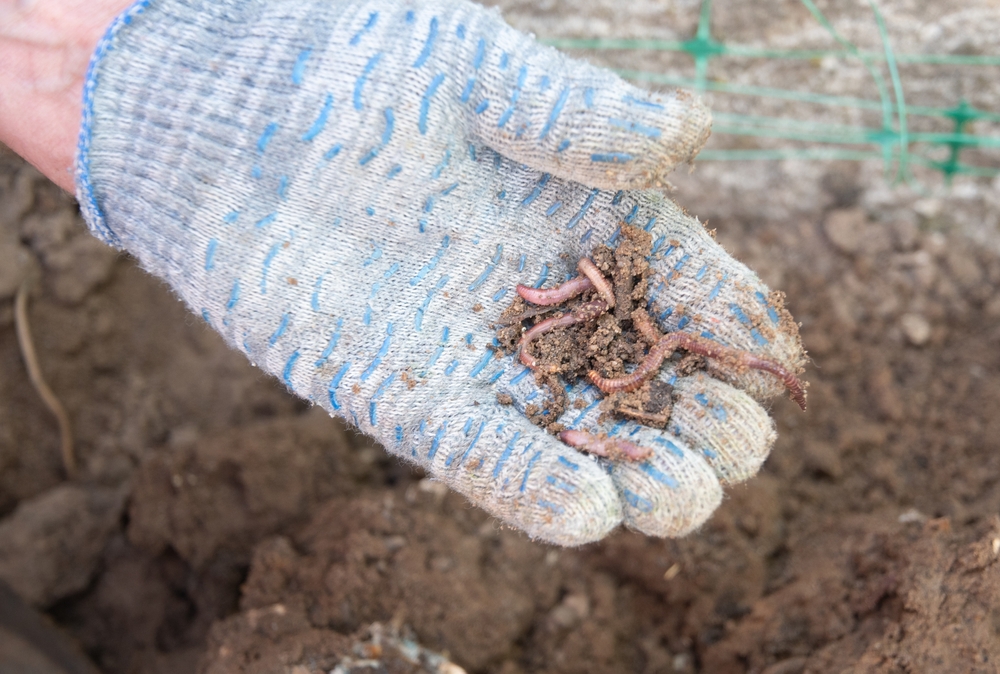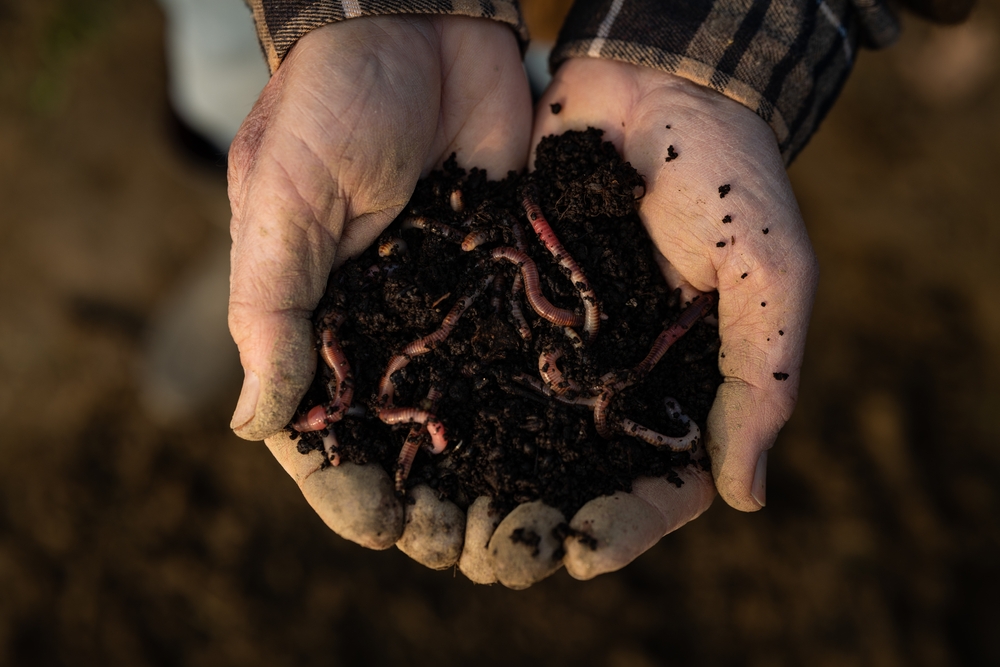
Image Source: Shutterstock.com
If you think fall is just about pumpkin spice and cozy sweaters, think again—beneath the fallen leaves and chilly air, an underground workforce is hustling harder than ever. While most creatures slow down as temperatures drop, earthworms are clocking in overtime, turning your soil into a nutrient-packed wonderland. You might not notice them, but these slimy, silent laborers are nature’s tiny tillers, working night shifts that keep gardens and forests thriving.
Fall is their season of glory—a time when moisture returns, leaves pile up, and the worms roll up their nonexistent sleeves. So, let’s dive into the dirt and uncover why these humble heroes are the unsung champions of autumn soil health.
Cooler Weather, Busier Worms
As summer heat fades, the ground cools to that perfect “Goldilocks zone” of temperature—just right for earthworms. Hot soil dries them out, while frozen soil locks them in place, but fall strikes a perfect balance that sends them into overdrive. Moisture from autumn rains seeps down, softening the earth and making it easier for worms to burrow, eat, and reproduce. You can actually spot more worm activity after a light rain—those glistening trails on sidewalks are signs of a soil system buzzing with life. Fall’s moderate conditions turn every garden into a subterranean construction site powered entirely by worms.
Nature’s Little Plowmen
When you imagine plowing, you might think of tractors or tillers—but earthworms have been doing it long before humans invented machinery. As they move through the soil, worms create tunnels that aerate the ground, allowing air and water to circulate more freely. In the fall, when the soil is heavy with moisture and organic matter, this natural tilling becomes even more effective. Their movement prevents compaction, which is crucial before winter sets in and freezes everything solid. So, while you’re raking leaves aboveground, the worms are busy making sure your spring seedlings will have soft, breathable soil to grow in.
The Great Leaf Feast
To an earthworm, fall is basically an all-you-can-eat buffet. Every crunchy leaf that hits the ground becomes a future meal, rich with organic matter and natural sugars. Worms drag these leaves into their burrows, munching away and breaking them down into a fine, nutrient-rich mix called castings. These castings are liquid gold for gardeners—they improve soil structure, retain moisture, and pack vital nutrients like nitrogen and phosphorus. While you’re sipping cider and admiring autumn colors, the worms are converting those fallen leaves into next year’s fertile foundation.
Underground Matchmakers
Here’s a fun fact: fall isn’t just a feeding frenzy for worms—it’s also mating season. The cool, moist soil provides the perfect conditions for reproduction, ensuring a strong population before winter arrives. Earthworms are hermaphrodites, meaning each one has both male and female reproductive organs, so pairing up is always productive. After mating, they lay tiny cocoons that will hatch into baby worms once the temperature warms again. That means when you’re planting spring flowers, you’re reaping the rewards of a worm population that spent fall expanding its workforce underground.
The Decomposition Dream Team
Earthworms don’t work alone—they’re part of a larger cleanup crew that includes bacteria, fungi, and other decomposers. But worms are the headliners, speeding up decomposition by shredding organic matter into smaller pieces that microbes can break down faster. In fall, with a fresh layer of leaves and decaying plant material on the ground, this team effort goes into full swing. Every leaf that disappears into the soil is being transformed into nutrients that feed future growth. Essentially, worms are nature’s recyclers, turning yesterday’s yard waste into tomorrow’s lush greenery.
Helping Gardens Prepare for Winter
If you’re a gardener, fall is the time to thank your worms—and maybe even help them out. As they work through the soil, they mix organic matter deep into the ground, which strengthens root systems before the cold sets in. Their tunnels allow water to drain properly, preventing winter flooding and root rot. The castings they leave behind enrich the soil with long-lasting nutrients that will be ready when spring arrives. Think of it like a pre-winter soil workout: by the time snow melts, your garden will be fitter than ever, thanks to those tireless underground trainers.

Image Source: Shutterstock.com
Why Fall Matters More Than You Think
Many people assume spring is the season of growth, but fall is the foundation that makes that growth possible. Worm activity during autumn directly influences how well plants will thrive months later. The nutrients they release now linger through the cold season, setting the stage for strong germination and early blooms. Without this behind-the-scenes work, soil could compact, lose structure, or drain poorly—all things that stunt growth come spring. In other words, every healthy garden is built on the invisible hustle of fall worms doing their thing when no one’s watching.
Supporting Your Soil’s Secret Workforce
If you want to give your local worms a helping hand, there’s one simple rule: don’t fight nature. Leaving a thin layer of fallen leaves, using compost, and avoiding heavy tilling all create an environment worms love. Chemical fertilizers and pesticides, on the other hand, can harm or repel them, undoing all their hard work. Letting your soil breathe and stay organic ensures that the worms can keep improving it naturally. The more you encourage them, the more resilient and fertile your soil will become year after year.
The Unsung Heroes Beneath Our Feet
When you think of fall, you might picture migrating birds, harvest festivals, or pumpkin patches—but the real heroes of the season are squirming below the surface. Earthworms don’t get headlines or hashtags, but their contributions to the ecosystem are monumental. Every inch they move, every leaf they digest, and every tunnel they create helps sustain the natural balance that everything else depends on. Without them, our gardens would struggle, forests would falter, and agriculture would be far less productive. So the next time you spot a worm after a rainstorm, give it a mental high-five—it’s probably been working harder than you all season.
The Fall Hustle of Nature’s Hidden Workers
As the air cools and the leaves drop, earthworms are quietly staging one of nature’s most impressive performances. They’re eating, digging, reproducing, and recycling—keeping ecosystems alive and fertile even as the world above slows down. Their fall hustle ensures that when spring arrives, life can burst back with vigor. These tiny soil engineers remind us that the most important work often happens where we can’t see it.
Have you noticed more worms in your fall garden? Share your thoughts, stories, or soil secrets in the comments.
You May Also Like…
Why Leaf Piles Attract Beneficial Insects
7 Innocent-Looking Shrubs That Harbor Invasive Insects
10 Ways Fallen Leaves Feed Your Soil
7 Insects Experts Warn Can Hitchhike Into Your House From the Garden
How Soil Biology Shifts After First Frost
Leave a Reply